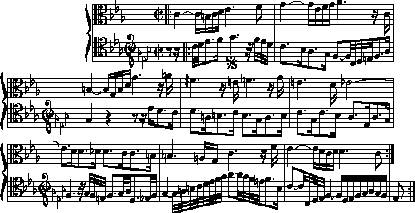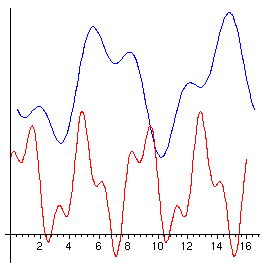Canon 4 Math and the Musical Offering
g(t) = -f((t-0.5)/2) + L and Canon 4
In Canon 4 (per Augmentationem contrario Motu) Voice 2 starts at the sign, one-half measure after Voice 1. The second clef is again upside-down, signalling that Voice 2 runs upside-down (as in Canon 3).

Graphic © 1996, Timothy A. Smith, used by permission.
The second clef is a treble clef and positions Voice 2 above the modified ``royal theme'' in the top staff. The ``royal theme'' now appears as a middle voice. But there is more: The ``per augmentationem'' in the title indicates that in Voice 2 each note has double the value that it had in Voice 1, so Voice 2 moves with half the speed of Voice 1.
 To make the function g copy the function f but move half as fast, we define g(t) = f(t/2) so that g(2) = f(1), g(4) = f(2), etc. To make g also start later and higher and move in the reverse direction, we combine the previous modifications and set
To make the function g copy the function f but move half as fast, we define g(t) = f(t/2) so that g(2) = f(1), g(4) = f(2), etc. To make g also start later and higher and move in the reverse direction, we combine the previous modifications and set
g(t) = -f((t-0.5)/2) + L. As in Canon 3, the L is chosen to position our graph approximately where Voice 2 is positioned. Note that it takes sixteen measures to hear the whole canon: Voice 1 has to play its tune twice before Voice 2 is finished.
Back to the ``Math and the Musical Offering'' Main Page.
On to the Next Example.
Welcome to the
Feature Column!
These web essays are designed for those who have already discovered the joys of mathematics as well as for those who may be uncomfortable with mathematics.
Read more . . .
Feature Column at a glance




 To make the function g copy the function f but move half as fast, we define g(t) = f(t/2) so that g(2) = f(1), g(4) = f(2), etc. To make g also start later and higher and move in the reverse direction, we combine the previous modifications and set
To make the function g copy the function f but move half as fast, we define g(t) = f(t/2) so that g(2) = f(1), g(4) = f(2), etc. To make g also start later and higher and move in the reverse direction, we combine the previous modifications and set